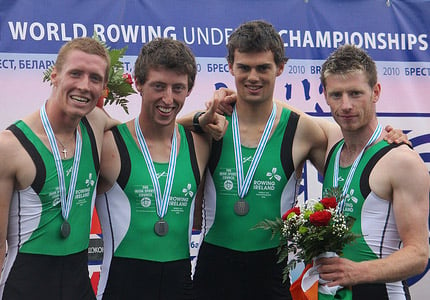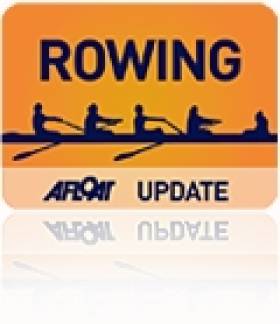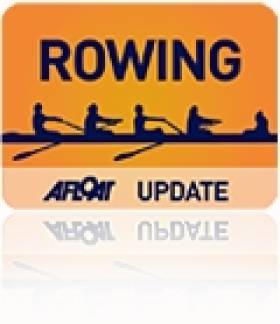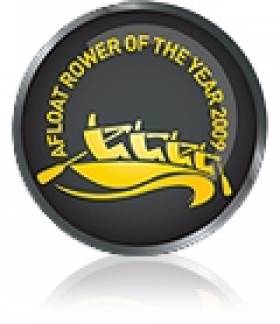Displaying items by tag: Justin Ryan
Cork and Shandon In Form at Muckross Head
#Rowing: Cork Boat Club’s intermediate eight proved the fastest crew at the Muckross Head of the River at the National Rowing Centre. Shandon, who had a set of good results, saw their eight finish just five seconds off that pace – and their junior 18 quadruple took just nine minutes and 48 seconds to cover the course, placing them seventh overall. Justin Ryan of Skibbereen was the fastest single sculler.
The adult women’s ranks were thinner in numbers. Monika Dukarska was the fastest single sculler. A masters women’s crew from Lady Elizabeth and Dublin University Ladies Boat Club won: it featured well-known names, including former internationals Vanessa Lawrenson and Heather Boyle.
Muckross Head of the River – Selected Results
Overall: 1 Cork BC intermediate eight 9 mins 20 sec, 2 Shandon inter eight 9:25, 3 UCC senior quadruple 9:35.
Men, Eight – Intermediate: Cork 9:20. Club One: UCC 9:35. Club Two: UCC 9:44. Jun 16: Fermoy 10:35. Masters: Castleconnell 13:25.
Four – Sen: Shandon 9:56. Inter, coxed: Skibbereen 10:36. Club One: UCC 10:33. Jun 18, coxed: Presentation Col (D Murphy) 11:07
Pair – Sen: Skibbereen 10:54. Jun 18: Shandon 10:55.
Sculling, Quadruple – Sen: UCC 9:35. Club One, coxed: UCC 13:05. Club Two, coxed: Workmen’s 11:05. Masters, coxed: Clonmel 13:26. Jun 18: Shandon 9:48. Jun 16, coxed: Lee 10:56.
Double – Sen: UCC 11:33. Inter: UCC 10:37. Club One: Shandon 11:09. Jun 18: Skibbereen 11:11. Jun 16: Shandon 11:28.
Single – Sen: Skibbereen (J Ryan) 11:26. Inter: Castleconnell (P Silke) 12:00. Club One: Castleconnell 12:15. Club Two: Cork (R Povey) 12:16. Jun 18: Shandon (E Gaffney) 11:39. Jun 16: Tralee (B Winde) 12:57. Masters (H, adjusted): Lee Valley 13:40 (11:36).
Women,
Eight – Club One: Lee Valley 13:08. Club Two: Shandon 11:12. Jun 16: Muckross 12:28. Masters: Lady Elizabeth, Trinity 12:35.
Four – Sen: Skibbereen 11:36. Inter, coxed: Skibbereen 12:53. Club Two, coxed: Cork 12:22.
Pair – Sen: UCC/Skib 11:58.
Sculling, Quadruple - Sen: Workmen’s 10:50. Club One, coxed: Fermoy 12:14. Club Two, coxed: Lee 12:35. Jun 18: Workmen’s 11:12. Jun 16, coxed: Lee 12:29.
Double – Sen: Cork 11:41. Club One: Workmen’s 12:00. Jun 18: Workmen’s 11:49. Jun 16: Killorglin 12:19.
Single – Sen: Killorglin (M Dukarska) 11:54. Inter: Skibbereen (L Heaphy) 13:09. Club One: Lee Valley 13:08. Club Two: Killorglin (E O’Donovan) 13:35. Jun 18: Kenmare (E Crowley) 13:19. Jun 16: Killorglin (R O’Donoghue) 13:19. Masters: Clonmel (F, adjusted) 14:54 (13:26)
Skibbereen Pick Up Wins at Limerick but McKeown Sees Off Ryan
#ROWING: Skibbereen won the men’s senior four and the intermediate coxed four at Limerick regatta at O'Brien's Bridge. Sam McKeown won the senior single sculls, beating Justin Ryan of Skibbereen, who has international experience as a lightweight sculler. Damien Kelly of Garda, who had finished second to McKeown in the intermediate final, was third. Portora had a day of wins at junior level, including the men’s and women’s junior 18 eights, the men’s junior 16 eight and the men’s junior 18 coxed quad and the women’s junior four and pair.
Limerick Regatta, O’Brien’s Bridge, Selected Results:
Men
Eight – Intermediate: 1 St Joseph’s, 2 St Michael’s. Junior 18: 1 Portora, 2 St Joseph’s, 3 St Michael’s. Junior 15: 1 St Joseph’s, 2 Shandon, 3 Portora.
Junior 16: 1 Portora, 2 Col Iognáid, 3 St Joseph’s. Masters: St Michael’s.
Four – Senior: 1 Skibbereen, 2 St Michael’s. Inter, coxed: 1 Skibbereen, 2 Portora, 3 St Michael’s. Jun 18A, coxed: 1 Portora A, 2 Athlunkard, 3 St Michael’s A.
Pair – Senior: 1 St Michael’s, 2 Neptune, 3 Shannon. Junior 18: 1 Athlunkard A, 2 Athlunkard B, 3 CAI B.
Sculling – Quadruple – Club Two: 1 Cork B, 2 Shandon, 3 Cork A. Junior 18A: 1 Cork A, 2 Lee, 3 Commercial. Jun 16, coxed: 1 Lee, 2 St Michael’s C, 3 Cork A. Jun 15, coxed, Final One: 1 Shandon A, 2 St Michael’s, 3 Killorglin. Final Two: Castleconnell.
Double – Inter: 1 Skibbereen, 2 Garda, 3 St Michael’s. Jun 15: 1 St Michael’s B, 2 Lee A, 3 Workmens.
Single – Senior: 1 Portadown (S McKeown), 2 Skibbereen (J Ryan), 3 Garda (Kelly). Intermediate: 1 Portadown (S McKeown), 2 Garda (D Kelly), 3 St Michael’s (D O’Connor). Novice: 1 Castleconnell (A Mozdzer), 2 Waterford (S O’Brien), 3 Lee (H Sutton). Junior 18: 1 Athlone (P Munnelly), 2 Graiguenamanagh (A Lennon), 3 Castleconnell (N Meehan). Masters: 1 St Michael’s (S O’Donnell), 2 Lee Valley (T Corcoran), 3 Shandon (J O’Neill).
Women
Eight – Junior 18: 1 Portora, 2 St Michael’s, 3 Galway. Jun 16: 1 Shandon, 2 Commercial, 3 Portora. Jun 15: 1 Portora, 2 St Michael’s. Masters: 1 Shannon.
Four – Inter, coxed: 1 Garda, 2 Athlunkard. Junior 18: 1 Portora A, 2 Galway, 3 St Michael’s.
Pair – Junior: 1 Portora, 2 Lee, 3 St Michael’s A.
Sculling, Quadruple – Club Two: 1 Fermoy, 2 Athlunkard, 3 Sligo. Novice, coxed: 1 Fermoy, 2 Univ of Limerick, 3 Lee. Junior 18: 1 Lee, 2 Fermoy, 3 Offaly. Jun 15, coxed: 1 Cork A, 2 Fermoy A, 3 Workmens.
Double – Senior: 1 Castleconnell, 2 Sligo. Junior 15: 1 Workmens, 2 Fermoy, 3 Lee A.
Single – Inter: 1 St Michael’s (A O’Sullivan), 2 Garda (J Ryan), 3 Fermoy (S Bouanane). Novice: 1 Castleconnell (R Kilkenny), 2 Fermoy (A Collins), 3 Univ of Limerick. Jun 18A: 1 Lee (E Cummin), 2 Lee (C Maguire), 3 Fermoy (S Cotter). Jun 16: 1 Lee (C Synnott), 2 Workmens (S Burns), 3 Fermoy (A O’Sullivan).
Puspure Withdraws From European Rowing Semi-Final
# ROWING: Sanita Puspure was withdrawn from the A/B semi-final of the single sculls at the European Rowing Championships in Seville today. Ireland Performance Director, Morten Espersen said that the decision was made this morning because the 31-year-old had flu-like symptoms. Puspure was very unwell and could not race.
John Keohane finished fifth in his C Final, 17th overall, while the Ireland lightweight double of Niall Kenny and Justin Ryan finished 21st overall with third pace in the D Final behind Slovakia and the Czech Republic. In the C/D semi-final they were competitive early but lost out when the second half of the race became a scramble for second and third places behind dominant winners Hungary. Ireland struggled to deal with the head wind and finished fifth.
European Rowing Championships, Seville, Day Two (Irish interest)
Men
Single Sculls – C Final (places 13 to 18): 1 Hungary 7:56.08; 5 Ireland (J Keohane) 8:03.54.
Lightweight Double Sculls – C/D Semi-Finals Two (First Three to C Final; rest to D Final): 1 Hungary 7:15.12, 2 Slovenia 7:18.43, 3 Bulgaria 7:18.64; 4 Slovakia 7:20.27, 5 Ireland (N Kenny, J Ryan) 7:26.76. D Final (places 19 to 22): 1 Slovakia 7:20.10, 2 Czech Republic 7:20.44, 3 Ireland 7:25.26, 4 Armenia 8:59.40.
Women
Single Sculls – A/B Semi-Final One: Ireland (S Puspure) Did not start.
Quadruple Scull Named Rowers of the Year
It was a good year for Irish rowing: among the highlights were an Ireland eight taking bronze at the World University Championships; John Keohane winning the single sculls title at the World Coastal Rowing Championships; Siohan McCrohan and Claire Lambe reaching A Finals at World Cup and European Championship level. At home, NUIG won the senior eights title after another great battle with Queen's. Standing out above the rest, however, is the achievements of the four men who made up the Lightweight Quadruple Scull which took silver at the World Under-23 Championships. Niall Kenny, Michael Maher, Mark O'Donovan and Justin Ryan (pictured below) are the Afloat Rowers of the Year 2010.

Rower of the Year award: The judging panel is made up of Liam Gorman, rowing correspondent of The Irish Times, President of Rowing Ireland Anthony Dooley and David O'Brien, Editor of Afloat magazine. Monthly awards for achievements during the year have appeared on afloat.ie. The overall national award goes to the person or crew who, in the judges' opinion, achieved the most notable results in, or made the most significant contribution to rowing during 2010. Thanks for your interest!































































